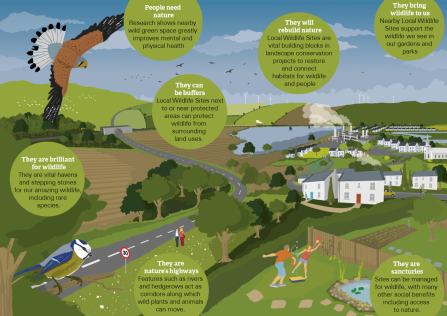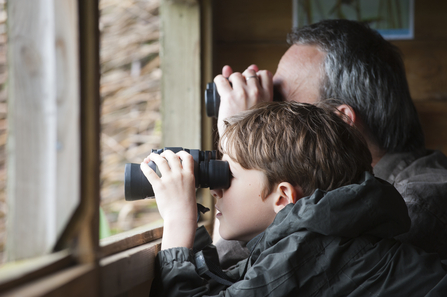LWS are the places where our wildlife lives
As changes in land use have eroded the natural habitats that once covered Powys, LWS are now ‘islands’ in a ‘sea’ of intensively-managed urban and rural landscapes. Alongside our statutory protected sites (SACs etc.), they support a wealth of wildlife, both common and rare.

LWS are the building blocks for the restoration of nature
To reverse the centuries long trend of wildlife loss and provide for natures recovery, we have to expand, restore and recreate habitats on a landscape scale, way beyond the boundaries of traditional nature reserves and wildlife sites. This is the Wildlife Trust’s vision for a Living Landscape.
The natural green LWS of our towns and countryside have a huge part to play. They make up a web of stepping stones and corridors for wildlife, forming key components of ecological networks.
LWS are as important to people as they are to wildlife
They contribute greatly to our quality of life, health, well-being and education, and add economic value to local communities.

Paul Harris/2020VISION
LWS are often privately owned with limited access
Despite this, the very existence of this natural habitat network contributes to the wildlife we find in our gardens, parks, and other public natural spaces.
LWS are free providers of vital services
Conventional economics ignores the natural services we rely on to maintain a healthy and sustainable environment – for example clean air and water, carbon storage, pollinators and food production, and flood resilience. LWS help provide these benefits for free.
Silvia Cojocaru
LWS are unable to survive indefinitely
Below a critical size, a wildlife-rich area lacks the resilience to withstand dramatic events such as disease, flood or drought, or the steady attrition of nearby hostile land use. Little by little, species start to disappear.
In Wales a LWS is called a Site of Importance for Nature Conservation (SINC).
How do LWS compare with other protected places?
There is a general misconception that all the best nature conservation sites are nationally designated and legally protected. This is not the case. While Sites of Special Interest (SSSIs) are crucially important, they represent only a small sample of our most important habitats and species. Many places are not designated as SSSIs, and have no legal; protection despite being of equal or greater value for wildlife. By contrast, for LWS, all sites which meet the given criteria are selected, some of which are SSSI quality. Consequently, in some counties LWS are where most of our special wildlife can be found.
On average 4% of Wales is designated (5,757 sites), which gives these sites some protection in the local planning system, and support through county networks for landowners. There are just 1,072 SSSIs. 62% of Torfaen is covered by LWS. SSSIs cover just 3.5%. 30x more of Caerphilly’s area is LWS than SSSI. Powys currently falls well below this, with 0.25% designated as LWS.
Who treasures and protects these places?
Because LWS are often privately owned, they rely on the sheer commitment of the landowners, farmers and volunteers who are prepared to carry out sensitive habitat management. Without such care and effort, a site will gradually decline. There are also many local organisations such as the Powys Wildlife Trusts who work in partnership to help care for these special places and advise landowners on land management and grants.
If you would like a survey of your wildlife site, know of a potential Local Wildlife Site or would like to volunteer your help for the project please contact Fiona Stone on fiona@rwtwales.org or 07377440887. Thank you.
Adapted from ‘A Short Guide to Local Wildlife Sites’ by The Wildlife Trusts 2019.
